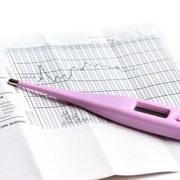
You might be interested in calculating the schedule of your ovulation phase during your menstrual cycle for a couple reasons. One reason would be if you are trying to avoid a pregnancy and will take extra precautions while you are ovulating, and the other is if you are specifically trying to get pregnant. When you are trying to get pregnant you will want to have intercourse during the time that you are ovulating for the best chance of conception. The window can be small and it is specific to each individual woman, so it might take some planning.
An ovulation calculator can be as simple as tracking some specific dates. You will need to know the day that you started your last menstrual period. If you do not know how long your menstrual cycle is, you will need to keep track of the days that you start menstruating for a couple months. An average menstrual cycle can last from 28-32 days and there are always outliers from the norm. If your cycle is on the shorter side at 28 days you may notice that you start your period at an earlier date the following month. If you have a longer cycle you might notice that the date you start you period seems to get pushed back, and if you have a 30-day cycle you might feel like you always start on the same day. Read these tips: healthstatus.com.
Your menstrual cycle starts on the day that you begin your period. From days 2 to 14 you will be in the follicular phase where the mucous in your cervix starts to thin. Ovulation can occur anywhere from day 11 to 21 of your cycle. You can track it more closely by paying attention to your body's temperature, as you will notice an increase when you are ovulating. The increase in body temperature can be attributed to the fact that your estrogen levels rise to trigger the release of the egg.
If an egg gets fertilized during this period, it can implant itself on days 23 and 24 of your cycle. This is the time when a pregnancy test will be likely to register the hormones that mean a pregnancy took place. If you do not get pregnant, during days 25-28 your hormone levels will fall and the walls of the uterus shed to prepare for another round, which is when your period takes place. Visit healthstatus.com/calculate/ovulation-calculator for your inquiries.
An ovulation calculator can be as simple as tracking some specific dates. You will need to know the day that you started your last menstrual period. If you do not know how long your menstrual cycle is, you will need to keep track of the days that you start menstruating for a couple months. An average menstrual cycle can last from 28-32 days and there are always outliers from the norm. If your cycle is on the shorter side at 28 days you may notice that you start your period at an earlier date the following month. If you have a longer cycle you might notice that the date you start you period seems to get pushed back, and if you have a 30-day cycle you might feel like you always start on the same day. Read these tips: healthstatus.com.
Your menstrual cycle starts on the day that you begin your period. From days 2 to 14 you will be in the follicular phase where the mucous in your cervix starts to thin. Ovulation can occur anywhere from day 11 to 21 of your cycle. You can track it more closely by paying attention to your body's temperature, as you will notice an increase when you are ovulating. The increase in body temperature can be attributed to the fact that your estrogen levels rise to trigger the release of the egg.
If an egg gets fertilized during this period, it can implant itself on days 23 and 24 of your cycle. This is the time when a pregnancy test will be likely to register the hormones that mean a pregnancy took place. If you do not get pregnant, during days 25-28 your hormone levels will fall and the walls of the uterus shed to prepare for another round, which is when your period takes place. Visit healthstatus.com/calculate/ovulation-calculator for your inquiries.


